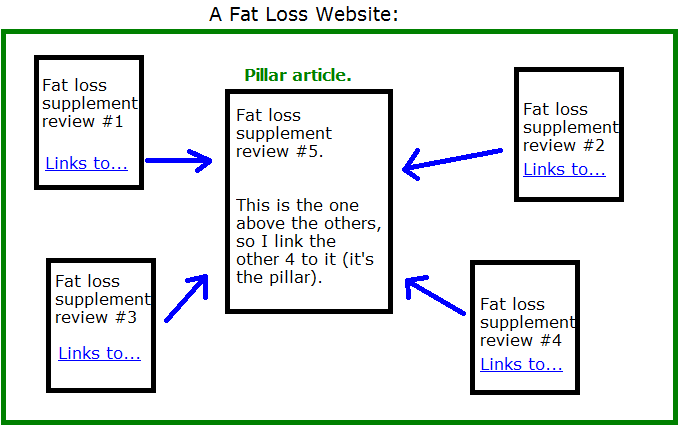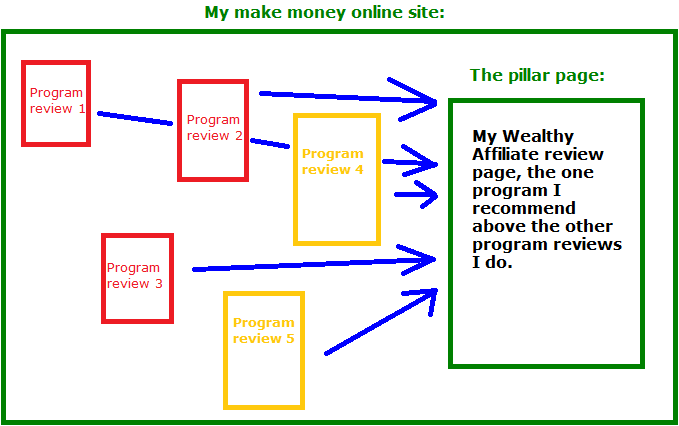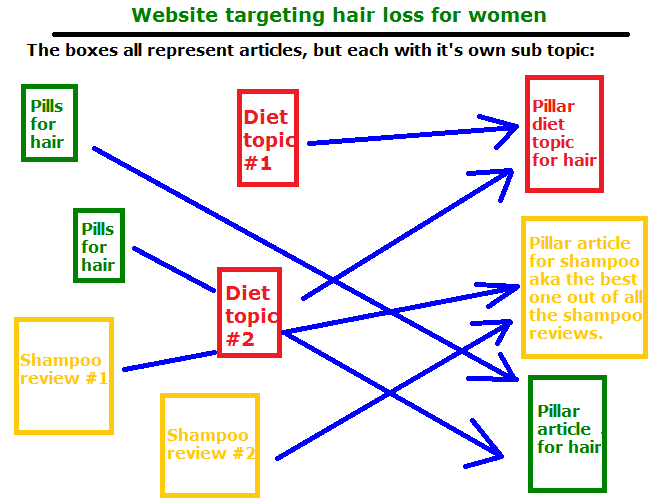Every single website and blog needs to have a single or multiple pillar pages if it intends to rank high on Google and/or make good money. But what is exactly is this?
It’s actually a very simple term, both in understanding and in doing, so let me help you understand it…
So what is a pillar page?
They are basically the “elite” pages/posts on your website which aim to funnel most of your website’s traffic into them.
A few great examples of pillar pages:
Example 1: Let’s say I run a fat loss blog in which I actively write about fat loss topics.
On this blog, let’s say I reviewed 50 fat loss supplements, on 50 different blog posts and out of that number, there’s only 1 which truly stands as the best.
From a monetary standpoint, it would be best that I link and recommend that 1 above all fat loss supplement above the other 49.
And if I do this, then guess what? That 1 blog post which has the best supplement is also my pillar page:
Example 2: This is more of an analogy, but I absolutely know it’ll help you understand this topic a lot better.
Suppose I decide to get martial arts training and have money to spend on private lessons. I find a school in my area, enter it and discover that there’s 5 different trainers to choose from.
How will I decide which one to pick?
Well I’ll look at their credentials and based off that, if I see that one of the 5 has the best reputation (let’s say they’re the most experienced, have real fights in the ring and real world experience, whereas the others don’t), I’ll likely pick that person to train me.
That trainer will be the “pillar” in that martial arts school that. Make sense?
Example 3 (My own personal one):
My website has 100’s of blog posts and about 50% of them (or more) are product reviews on make money online programs. Well, all of them link back to what I classify as my “#1 recommendation”, Wealthy Affiliate.
And you may have already guessed it, but the Wealthy Affiliate article IS the main pillar article in this case. Here’s how that looks:
Also I have a number of other pillar pages, including this one on affiliate marketing. It’s over 5,000 words long.
My home page. I send a lot of visitors who come to one of my 900+ pages there because it converts well and provides great information.
An article where I described 100 niches to make money from. This one had over 5,000 words and I also link to it fairly often.
I link people to these particular pages (there’s more, but these were examples) because they have a lot of great content that I know people enjoy reading and taking action from, like getting into the Wealthy Affiliate program, which makes me money.
Ok Vitaliy, should I have 1 or multiple pillar pages?
I would say in most cases, stick to having MULTIPLE ones your site, not one. Here’s why:
A website which covers a particular topic or niche (preferably) needs to SEGMENT it’s content into sub topics and in each sub topic, link to a pillar article which corresponds to it.
That would be the best policy I’d recommend you follow and before you tell me you have no idea what I just said…
Hang on, hang on, here’s the example that’ll clear this up:
Let’s assume I have a niche website that deals with hair loss solutions for women (it’s a hungry niche).
Even if you don’t know squat about this topic, we can all agree that there’s different solutions to this problem. You have:
- Books and eBooks which talk about solving hair loss problems.
- Shampoos that restore hair.
- Supplements that restore hair.
- Diets that restore hair.
Those are basically 4 different SUB TOPICS within the main niche topic of hair loss for women. There’s more than 4, but let’s keep it simple…
I COULD technically link all the articles I write on the sub topics to a single article and that would be my main pillar on the site, but it wouldn’t make much sense to do it.
If you’re wondering why, then the answer is that if someone lands on my site looking for shampoos to restore their hair and I recommend to them an eBook instead, they probably won’t take that seriously. They are looking for a shampoo, not an eBook so it would be best that I link them to one.
Anyway…
Now here’s where this original example becomes important:
Let’s say I blog about and write reviews on 10 different eBooks for hair loss and discover one of these eBooks to be the best choice for helping my niche audience solve their problem.
Guess what? I’ll be linking the other 9 book reviews to that 1 review and it’ll be my pillar page for that SUB TOPIC.
Now let’s say I review 10 different shampoo products. Out of them, 1 is the best in my view, so that 1 review is where the other 9 will link to.
And once again, that 1 shampoo article will be my pillar page. Again, we have a specific sub topic (shampoos) and 1 main article out of the bunch where I promote the best shampoo.
Then let’s say I write 10 different reviews on supplements that aid in hair loss and once again, 1 seems to be better than the other 9.
Therefore, I will make that 1 review my main recommendation (you already know what that’s called, hint, hint) and link the other 9 reviews to it.
Do I even need to give you an example of the last one at this point? I doubt it.
But at least now that you have this example of sub topics and having 1 main one in each topic be the recommendation, suddenly that explanation I gave above isn’t so complex anymore right? 🙂
How this looks (in pillar page form):
Exceptions to the pillar page “rule”:
The fact of the matter is that it’s not always necessary to have a 1 “above all” pillar page/s on your website.
For example: Sometimes (and actually often) you will find that out of the product reviews you do, you won’t always have “just 1” product above all to recommend, you may have multiple ones. Fine, just link the bad ones to the one that’s good and the remaining ones which are good, link them to the direct offer itself.
So if I have 50 review posts, 10 of them are positive reviews and 1 is the best, I’ll probably just link the 10 good ones directly to the offer as an affiliate and the other 50 to the 1 that is the best. Make sense?
My final thoughts:
You don’t always have to adhere to these rules. In fact, this is not even a rule, it’s just smart to do this if you want get higher rankings and more sales.
Very often, it’s good to have one or more of these authority pages on your site so both your audience and search engines see that you are picky in your recommendations and advice.
People who do nothing but have every single product review be a recommendation to their audience generally have less authority in the eyes of their readers. It’s simply impossible for every product review you do to be a good product. There have to be distinctions between them and there HAVE to be ones that are better than others.
By helping your incoming traffic see which products and topics are above the others, you help give them better answers to their questions and in turn create pillar pages that direct them to the best answer to their questions/problems.




Thank you Vitaliy for breaking down exactly what a pillar page is. I’ve also heard it called pillar posts or evergreen content. I’m assuming they are all the same thing (correct me if I’m wrong.) Sometimes it’s difficult to have pillar pages when your content is seasonal or if you’re not comparing different products. For example, if someone has a food blog. What would you recommend they do instead? Overall, I enjoyed reading the different practical examples you gave that clearly explains how we can use pillar pages effectively!
Hi Max, for food blogs, you can discuss recipes on single posts and then have a pillar page be some sort of top 10 recipe book or top 100. Regarding pillar posts, yes those are the same thing. However, evergreen content is a bit different, it’s basically the process of creating more and more content for your site. Here’s more info regarding that stuff.
Hey Vitaliy:
Thanks for a beautifully clear explanation on how to structure inner links in a blog. I was having trouble deciding how to do that and your way sure does help me understand it better. Now I’ve got to go through my posts and see whether I can figure out which ones deserve pillar status.
Oh, joy!
You don’t have to focus so much on linking all your posts to a pillar page, just start by going through existing pages and seeing where you can just interlink them with other posts on your site, this will really help Google crawl your site better and help it do better in SEO.